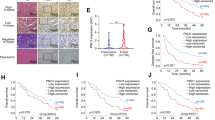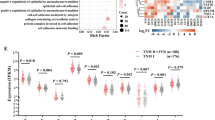Abstract
The roles of concealed microproteins encoded by long noncoding RNAs (lncRNAs) are gradually being exposed, but their functions in tumorigenesis are still largely unclear. Here, we identify and characterize a conserved 99-amino acid microprotein named KRASIM that is encoded by the putative lncRNA NCBP2-AS2. KRASIM is differentially expressed in normal hepatocytes and hepatocellular carcinoma (HCC) cells and can suppress HCC cell growth and proliferation. Mechanistically, KRASIM interacts and colocalizes with the KRAS protein in the cytoplasm of human HuH-7 hepatoma cells. More importantly, the overexpression of KRASIM decreases the KRAS protein level, leading to the inhibition of ERK signaling activity in HCC cells. These results demonstrate a novel microprotein repressor of the KRAS pathway for the first time and provide new insights into the regulatory mechanisms of oncogenic signaling and HCC therapy.
Similar content being viewed by others
References
Anderson, D.M., Anderson, K.M., Chang, C.L., Makarewich, C.A., Nelson, B.R., McAnally, J.R., Kasaragod, P., Shelton, J.M., Liou, J., Bassel-Duby, R., et al. (2015). A micropeptide encoded by a putative long noncoding RNA regulates muscle performance. Cell 160, 595–606.
Bernards, A. (2003). GAPs galore! A survey of putative Ras superfamily GTPase activating proteins in man and Drosophila. BioChim Biophysica Acta (BBA) — Rev Cancer 1603, 47–82.
Calviello, L., Mukherjee, N., Wyler, E., Zauber, H., Hirsekorn, A., Selbach, M., Landthaler, M., Obermayer, B., and Ohler, U. (2016). Detecting actively translated open reading frames in ribosome profiling data. Nat Methods 13, 165–170.
Choi, S.W., Kim, H.W., and Nam, J.W. (2018). The small peptide world in long noncoding RNAs. Brief Bioinform 81.
Colicelli, J. (2004). Human RAS superfamily proteins and related GTPases. Sci Signal 2004(250), re13.
Deng, P., Liu, S., Nie, X., Weining, S., and Wu, L. (2018). Conservation analysis of long non-coding RNAs in plants. Sci China Life Sci 61, 190–198.
Dietrich, P., Koch, A., Fritz, V., Hartmann, A., Bosserhoff, A.K., and Hellerbrand, C. (2018). Wild type Kirsten rat sarcoma is a novel microRNA-622-regulated therapeutic target for hepatocellular carcinoma and contributes to sorafenib resistance. Gut 67, 1328–1341.
Dong, B., Liang, Z., Chen, Z., Li, B., Zheng, L., Yang, J., Zhou, H., and Qu, L. (2018). Cryptotanshinone suppresses key onco-proliferative and drug-resistant pathways of chronic myeloid leukemia by targeting STAT5 and STAT3 phosphorylation. Sci China Life Sci 61, 999–1009.
Downward, J. (2003). Targeting RAS signalling pathways in cancer therapy. Nat Rev Cancer 3, 11–22.
Eddy, S.R. (2001). Non-coding RNA genes and the modern RNA world. Nat Rev Genet 2, 919–929.
Eddy, S.R. (2002). Computational genomics of noncoding RNA genes. Cell 109, 137–140.
Gagnon, K.T., Li, L., Janowski, B.A., and Corey, D.R. (2014). Analysis of nuclear RNA interference in human cells by subcellular fractionation and Argonaute loading. Nat Protoc 9, 2045–2060.
Gysin, S., Salt, M., Young, A., and McCormick, F. (2011). Therapeutic strategies for targeting ras proteins. Genes Cancer 2, 359–372.
Hein, M.Y., Hubner, N.C., Poser, I., Cox, J., Nagaraj, N., Toyoda, Y., Gak, I.A., Weisswange, I., Mansfeld, J., Buchholz, F., et al. (2015). A human interactome in three quantitative dimensions organized by stoichiometries and abundances. Cell 163, 712–723.
Hilger, R.A., Scheulen, M.E., and Strumberg, D. (2002). The Ras-Raf-MEK-ERK pathway in the treatment of cancer. Oncol Res Treat 25, 511–518.
Huang, J.Z., Chen, M., Chen, D., Gao, X.C., Zhu, S., Huang, H., Hu, M., Zhu, H., and Yan, G.R. (2017). A peptide encoded by a putative lncRNA HOXB-AS3 suppresses colon cancer growth. Mol Cell 68, 171–184.e6.
Ingolia, N.T., Brar, G.A., Stern-Ginossar, N., Harris, M.S., Talhouarne, G.J. S., Jackson, S.E., Wills, M.R., and Weissman, J.S. (2014). Ribosome profiling reveals pervasive translation outside of annotated protein-coding genes. Cell Rep 8, 1365–1379.
Ji, Z., Song, R., Regev, A., and Struhl, K. (2015). Many lncRNAs, 5’UTRs, and pseudogenes are translated and some are likely to express functional proteins. eLife 4, e08890.
Karnoub, A.E., and Weinberg, R.A. (2008). Ras oncogenes: split personalities. Nat Rev Mol Cell Biol 9, 517–531.
Katayama, H., Nagasu, T., and Oda, Y. (2001). Improvement of in-gel digestion protocol for peptide mass fingerprinting by matrix-assisted laser desorption/ionization time-of-flight mass spectrometry. Rapid Commun Mass Spectrom 15, 1416–1421.
Kawada, K., Toda, K., and Sakai, Y. (2017). Targeting metabolic reprogramming in KRAS-driven cancers. Int J Clin Oncol 22, 651–659.
Kim, M., and Slack, F.J. (2014). MicroRNA-mediated regulation of KRAS in cancer. J Hematol Oncol 7, 84.
Kolch, W. (2000). Meaningful relationships: the regulation of the Ras/Raf/MEK/ERK pathway by protein interactions. Biochem J 351, 289–305.
Li, X., Wang, W., and Chen, J. (2017). Recent progress in mass spectrometry proteomics for biomedical research. Sci China Life Sci 60, 1093–1113.
Librado, P., and Rozas, J. (2009). DnaSP v5: a software for comprehensive analysis of DNA polymorphism data. Bioinformatics 25, 1451–1452.
Liu, P., Yang, H., Zhang, J., Peng, X., Lu, Z., Tong, W., and Chen, J. (2017). The lncRNA MALAT1 acts as a competing endogenous RNA to regulate KRAS expression by sponging miR-217 in pancreatic ductal adenocarcinoma. Sci Rep 7, 5186.
Makarewich, C.A., Baskin, K.K., Munir, A.Z., Bezprozvannaya, S., Sharma, G., Khemtong, C., Shah, A.M., McAnally, J.R., Malloy, C. R., Szweda, L.I., et al. (2018). MOXI is a mitochondrial micropeptide that enhances fatty acid β-Oxidation. Cell Rep 23, 3701–3709.
Matsumoto, A., Pasut, A., Matsumoto, M., Yamashita, R., Fung, J., Monteleone, E., Saghatelian, A., Nakayama, K.I., Clohessy, J.G., and Pandolfi, P.P. (2017). mTORC1 and muscle regeneration are regulated by the LINC00961-encoded SPAR polypeptide. Nature 541, 228–232.
McCubrey, J.A., Steelman, L.S., Chappell, W.H., Abrams, S.L., Wong, E. W.T., Chang, F., Lehmann, B., Terrian, D.M., Milella, M., Tafuri, A., et al. (2007). Roles of the Raf/MEK/ERK pathway in cell growth, malignant transformation and drug resistance. BioChim Biophysica Acta (BBA) — Mol Cell Res 1773, 1263–1284.
Ota, T., Suzuki, Y., Nishikawa, T., Otsuki, T., Sugiyama, T., Irie, R., Wakamatsu, A., Hayashi, K., Sato, H., Nagai, K., et al. (2004). Complete sequencing and characterization of 21,243 full-length human cDNAs. Nat Genet 36, 40–45.
Polycarpou-Schwarz, M., Groß, M., Mestdagh, P., Schott, J., Grund, S.E., Hildenbrand, C., Rom, J., Aulmann, S., Sinn, H.P., Vandesompele, J., et al. (2018). The cancer-associated microprotein CASIMO1 controls cell proliferation and interacts with squalene epoxidase modulating lipid droplet formation. Oncogene 37, 4750–4768.
Razooky, B.S., Obermayer, B., O’May, J.B., and Tarakhovsky, A. (2017). Viral infection identifies micropeptides differentially regulated in smORF-containing lncRNAs. Genes 8, 206.
Ruiz-Orera, J., Messeguer, X., Subirana, J.A., and Alba, M.M. (2014). Long non-coding RNAs as a source of new peptides. eLife 3, e03523.
Siepel, A., Pollard, K.S., and Haussler, D. (2006). New methods for detecting lineage-specific selection. (Berlin, Heidelberg, Springer Berlin Heidelberg), pp. 190–205.
Simanshu, D.K., Nissley, D.V., and McCormick, F. (2017). RAS proteins and their regulators in human disease. Cell 170, 17–33.
Slavoff, S.A., Mitchell, A.J., Schwaid, A.G., Cabili, M.N., Ma, J., Levin, J. Z., Karger, A.D., Budnik, B.A., Rinn, J.L., and Saghatelian, A. (2013). Peptidomic discovery of short open reading frame-encoded peptides in human cells. Nat Chem Biol 9, 59–64.
Stein, C.S., Jadiya, P., Zhang, X., McLendon, J.M., Abouassaly, G.M., Witmer, N.H., Anderson, E.J., Elrod, J.W., and Boudreau, R.L. (2018). Mitoregulin: A lncRNA-Encoded microprotein that supports mitochondrial supercomplexes and respiratory efficiency. Cell Rep 23, 3710–3720.e8.
Thasler, W.E., Weiss, T.S., Schillhorn, K., Stoll, P.T., Irrgang, B., and Jauch, K.W. (2003). Charitable state-controlled foundation human tissue and cell research: Ethic and legal aspects in the supply of surgically removed human tissue for research in the academic and commercial sector in Germany. Cell Tissue Banking 4, 49–56.
Vigil, D., Cherfils, J., Rossman, K.L., and Der, C.J. (2010). Ras superfamily GEFs and GAPs: validated and tractable targets for cancer therapy? Nat Rev Cancer 10, 842–857.
Wang, L.Q., Yu, P., Li, B., Guo, Y.H., Liang, Z.R., Zheng, L.L., Yang, J.H., Xu, H., Liu, S., Zheng, L.S., et al. (2018). miR-372 and miR-373 enhance the stemness of colorectal cancer cells by repressing differentiation signaling pathways. Mol Oncol 12, 1949–1964.
Xiao, Z., Huang, R., Xing, X., Chen, Y., Deng, H., and Yang, X. (2018). De novo annotation and characterization of the translatome with ribosome profiling data. Nucleic Acids Res 46, e61.
Yeasmin, F., Yada, T., and Akimitsu, N. (2018). Micropeptides encoded in transcripts previously identified as long noncoding rnas: A new chapter in transcriptomics and proteomics. Front Genet 9, 144.
Zhang, Q., Vashisht, A.A., O’Rourke, J., Corbel, S.Y., Moran, R., Romero, A., Miraglia, L., Zhang, J., Durrant, E., Schmedt, C., et al. (2017). The microprotein minion controls cell fusion and muscle formation. Nat Commun 8, 15664.
Acknowledgements
We thank Shujuan Xie for providing the normal liver tissues and the corresponding paracancer tissue samples. This work was supported by the National Key Research and Development Program of China (2017YFA0504400), the National Natural Science Foundation of China (31370791, 31671349, 31770879), Fundamental Research Funds for the Central Universities (14lgjc18). This research was supported in part by the Guangdong Province Key Laboratory of Computational Science (13lgjc05) and the Guangdong Province Computational Science Innovative Research Team (14lgjc18).
Author information
Authors and Affiliations
Corresponding authors
Rights and permissions
About this article
Cite this article
Xu, W., Deng, B., Lin, P. et al. Ribosome profiling analysis identified a KRAS-interacting microprotein that represses oncogenic signaling in hepatocellular carcinoma cells. Sci. China Life Sci. 63, 529–542 (2020). https://doi.org/10.1007/s11427-019-9580-5
Received:
Accepted:
Published:
Issue Date:
DOI: https://doi.org/10.1007/s11427-019-9580-5




